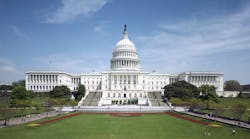The United States government is now in its second day of a partial shutdown, due to the inability of Congress to pass a Continuing Resolution to fund the government’s day-to-day operations.
As is well known by now, that fight is driven by the tenacious efforts of a minority of so-called “cast-iron conservatives” within the House GOP caucus who are determined to roll back or at least rewrite parts of President Obama’s signature Patient Protection and Affordable Care Act (ACA) – a.k.a. “Obamacare.”
But where the winner-take-all power politics now playing out inside the Beltway may ultimately land the nation’s economy should be seen as the ultimate concern of all Americans.
At least as far as the federal regulation of trucking is concerned, it’s business as usual. For now , anyhow.
According to the Dept. of Transportation’s (DOT) 2014 Plan for Appropriation Lapse, which was updated on Sept. 27th, the Federal Motor Carrier Safety Administration (FMCSA) and the Federal Highway Administration ( FHWA) will remain operational during the government shutdown as both agencies “have sufficient balances of liquidating cash to operate for a limited period during a lapse of annual appropriations.”
The plan states that “All operations continue as normal during a lapse in annual appropriations.” DOT specified that none of the FMCSA’s 1,102 employees or the FHWA’s 2,914 employees will be furloughed. But that may change if theshutdown drags on too long.
“Once available liquidating cash is exhausted to support continuing operations,” the plan notes regarding FMCSA, “an agency shutdown may need to be implemented. For a brief funding lapse, this is not anticipated.”
Indeed, as these agencies are funded by the Highway Trust Fund via multi-year spending bills, they are not dependent on annual Congressional appropriations.
And that brings to mind what may happen with the next surface-transportation funding reauthorization. Although the current MAP-21 highway funding bill won’t run out for another 364 days, it’s hard to imagine given the current intensely partisan climate that the atmosphere on Capitol Hill will clear enough by then to allow its replacement measure to move swiftly through the legislative process.
That much will change by then in Congress is doubtful, given the government has been shut down for the first time in 17 years and that the mid-term elections won’t take place for another 34 days after a new highway bill is due for passage
Of far, far bigger and nearly immediate concern is whether or not a deal will be reached between the White House, the Democratic-controlled Senate and the Republican-controlled House over raising the nation’s debt ceiling limit.
If that doesn’t happen by Oct. 17, the United States government will for the first time ever go into default.
“The last time the government shutdown was in the mid-nineties and lasted for three weeks with a minimal impact to growth, but Republicans took a huge hit as they were ultimately the party blamed for the shutdown,” pointed out Lindsey M. Piegza, managing director & chief economist of Sterne Agee, a privately owned brokerage firm,in an emailed statement.
“This time around, however, politicians should keep in mind that consumers are increasingly sensitive to a shutdown and political theater on Capitol Hill because the budget debate last year resulted in a very onerous payroll tax increase at the start of this year,” Piezga added. “Meaning the downward effect on confidence is likely to be exacerbated. The impact on GDP will very much be determined by the extent of the shutdown.”
If the government does wind up unable at meet its financial obligations, per a report posted by USA Today, the tumultuous effects on the economy would include:
- If the markets become concerned about even the possibility of a government default, a sell-offs of U.S. Treasury bonds could result. That would in turn hike interest rates across the board. That would lead to higher mortgage rates and borrowing costs for everyone-- creating inflation and putting a drag on the economy.
- If interest rates rise and debt- holders unload their bonds, a market panic similar to the stock market crash of 2008-- but possibly worse—could result. No one knows for sure what would happen—the U.S. government has never gone into default—and the unpredictability would fuel the market unrest.”
- Even If Congress eventually resolves the fiscal crisis, a federal default could lead credit-rating agencies to permanently downgrade U.S. debt… “the impasse could have long-standing effects on America's economic standing in the world…”
And if all that comes to pass, the immense ripple effects just from those three impacts alone would likely send the U.S. economy, if not the world’s as well, into a very deep recession.
Complicating matters, it now appears extremely likely that a resolution to the shutdown will become inexorably linked to cutting a deal to raise the all-important debt ceiling limit.
Consider for example that now, per an opinion blog post by Greg Sargent in The Washington Post , there is “serious talk among Democrats of not accepting a GOP budget offering [to end the shutdown] unless it also includes a debt limit hike if this shutdown crisis drags on.”
At the very least, as pointed out in a news post by Politico.com, the shutdown could persist for weeks until Congress and the White House broker a deal to on the national-debt limit.
The Politico.com reporters of the piece point out that “Even if the issues become connected, administration officials said it won’t change the underlying dynamics of the President’s position-- that he won’t negotiate over the debt limit.”
Reflecting that state of affairs as well from the other side of the political aisle, the news story quotes Sen. Tom Coburn (R-OK) as saying, “It will all get solved at one time.”
Click here to view an infographic posted by Slate.com that answers the question “Who’s Been Most Shut Down by the Shutdown?”



